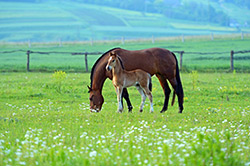Ticks! Basic Steps that Offer Equine Protection

It’s tick season once again, which means it is time to check (and double-check) the horses for those nasty blood-sucking arachnids that can transmit the diseases that make our animals ill. Passing on the following four tips could help to lessen certain tick problems your clients may encounter.
Tip #1: Analyze the Environment
The best opportunities for a horse to come into contact with ticks arise when they are at pasture or when in a wooded area. It is important that clients know how to recognize the environment where ticks thrive in order to reduce the chances for exposure.
- Ticks prefer areas of brushy overgrowth that provide:
- Humidity
- Direct sunlight protection
- Shelter for host animals that include: mammals, reptiles, birds, amphibians.
- Ticks are generally not found in areas with:
- Dry undergrowth
- Direct sunlight.
Tip #2: Pasture Management
Proper pasture management is crucial when attempting to eliminate tick problems. Clients should be made aware of the following steps to properly take care of the pasture and grazing fields that their animals inhabit.
- Mow pastures and grazing areas to keep grass and weeds cut short.
- Brush removal will reduce the protected areas that ticks need to survive and will also deter host wildlife that could reintroduce ticks to the area.
- Fields with severe tick infestations may require an application of acaricide—a tick and mite killing insecticide—and clients need to know to heed the manufacturer warnings and application instructions, such as:
- Certain chemicals vary in toxicity and their application could negatively impact humans, pets, farm animals, wildlife, aquatic organisms and beneficial insects if used incorrectly.
- The type of tick defines the method and optimal seasonal time of application.
- Weather may minimize the effectiveness of the application.
- Grazing restrictions or the temporary removal of animals from a pasture may be recommended at the time of application.
- Precautions may be listed in regard to pasturing breeding stock in treated fields during application.
Tip #3: Protection While Riding
Products to repel ticks are available in a wipe-on or spray-on form for use when riding in tick-infested areas. These products can provide several hours of protection when applied correctly. Instruct clients of the following points when using these products:
- Closely read and follow the directions and safety precautions when applying any acaricide or repellent.
- Make sure to treat the head, throat latch, chest, legs, underbelly, and under the tail area.
- Because ticks prefer feeding where the hair coat is thin, attachment sites commonly occur along the areas where the horse’s legs join its body. Make sure to check these areas closely for any ticks that may have crawled this high on the horse.
- Reapplication may be necessary as the accumulation of water, dust, dirt, and perspiration will shorten the length of protection time.
- Check horses during and when finished with the ride.
- If possible, spray the horse down with water following riding to remove ticks that may be on the horse but are not yet attached.
Tip #4: Tick Removal
Ticks that are found on a horse but are not yet attached to the skin can be removed easily and should be disposed of by placing in a container of rubbing alcohol. Ticks that are found attached to the skin should be removed as follows:
- Use tweezers to grasp the head or as close to the animal’s skin as possible.
- Pull back to remove the tick with a slow, steady, and straight pull.
- Clean the bite site, and then treat with an antiseptic ointment.
Sometimes when an attached tick is removed, its head and/or mouthparts remain embedded in the skin, and redness and swelling may occur. In this case, advise clients to continue to:
- Keep the site clean.
- Apply antibiotic ointment.
- Watch for increased redness or heat.
If the site appears to become infected or the redness seems to worsen, clients should contact their veterinarian.
Ticks are hardy and can transmit illness to both humans and horses. These tips will help to make clients aware of some of the basic steps to take when establishing protection against these disease-causing organisms.
For more information on equine protection and keeping animals safe, contact your Covetrus representative at 855.724.3461 or visit our product page for more information about equine health care!


Working Here
Our team members are encouraged to be the best they can be... at Covetrus we believe we impact one another.
Learn MoreNews & Events
FDA Cautions Pet Owners Not to Feed Texas Tripe Inc. Raw Pet Food Due to Salmonella, Listeria Monocytogenes
The U.S. Food and Drug Administration is cautioning pet owners not to feed their pets any of the Texas Tripe brand raw frozen pet food listed below because several samples of Texas Tripe raw pet food have tested positive for Salmonella and/or L. mono.
Careers
Are you looking for a place to let your talents shine? At Covetrus, we help our practitioner customers better serve their patients and take pride in providing the best customer experience possible. Search our open positions to see our available opportunities.
Newsletter
Stay current with what’s going on with Covetrus, subscribe to receive our newsletter and email communications. Subscribers will receive the latest information in practice management, sales and marketing, animal health, and more.



-3-(1).png?sfvrsn=2d806d73_0)

Leave a comment